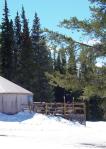Gerald Gardner in the 1940s
Capall Bann have published Philip Heselton's second volume exploring the origins of contemporary Wicca,
Gerald Gardner and the Cauldron of Inspiration. (Am I the only one who thinks that that title seems awfully Harry Potterish?) Capall Bann's distribution is not great outside the UK, but North American readers can order it
here.

Heselton continues to do a fine job ferreting out information on Gardner and his associates: letters, obscure publications, even Ordnance Survey maps from the 1930s showing whose house was located in relation to someone else's house. He is an outstanding researcher. Read this book and you will learn about many interesting things tangential to Wiccan history, such as the beginnings of organized nudism in the UK. (Those "Moonella" people were a hoot!)
Unfortunately, Heselton is blinded by the myth: the hidden coven at the Rosicrucian Theatre, Gardner's purported 1939 initiation in Dorothy Clutterbuck's house, the alleged Lammas 1940 ritual to stop the planned German invasion--all of it. (And, at one time, so was I.)
Instead, Ronald Hutton's suggestion in
The Triumph of the Moon, that there was no Wicca as a consciously Pagan "Old Religion" until about 1950 or 1951, is more likely true. Heselton's new evidence actually supports that conclusion even better than did Hutton's, but Heselton, a "true believer", will not admit it.
Throughout the 1940s, when Gardner supposedly was already a Wiccan initiate, he was chasing after other religious credentials. He was ordained by an esoteric splinter of mystical Christians, the Ancient British Church, part of the maverick "Old Catholic" movement. He joined the Druid Order. He persuaded Aleister Crowley to give him credentials in his magical order, the OTO.
Do these seem like the actions of a man who has already found what he was looking for?
When Gardner
does does find -- or co-create, with Edith Woodford-Grimes (Dafo) -- what he is looking for, he commits himself totally to promoting it, which he does with Wicca in the 1950s.
Heselton's account of how Gardner financially backed and supplied exhibits for Cecil Williamson's Witchcraft Museum on the Isle of Man leads me to speculate still further. In May 1951 Gardner writes to Williamson about how he can "fake up" this item or that for the displays, such as ritual swords. I begin to wonder how much of Wicca was created in a hurry in order to supply a "back story" for the museum exhibits. In order to have an exhibit about witches, we must have witches.
The repeal in 1951 of the Witchcraft Act of 1735 after the
Helen Duncan affair during World War II was a wonderful "cosmic coincidence."
As Aidan Kelly pointed out in
Crafting the Art of Magic, his own study of Gardnerian origins (published by Llewellyn in 1991, now out of print), Gardner was always the only source of information about the "Southern Coven of British Witches." I do not see Heselton really developing any alternative authoritative source, although he fills in many gaps in the narrative.
 Heselton continues to do a fine job ferreting out information on Gardner and his associates: letters, obscure publications, even Ordnance Survey maps from the 1930s showing whose house was located in relation to someone else's house. He is an outstanding researcher. Read this book and you will learn about many interesting things tangential to Wiccan history, such as the beginnings of organized nudism in the UK. (Those "Moonella" people were a hoot!)
Heselton continues to do a fine job ferreting out information on Gardner and his associates: letters, obscure publications, even Ordnance Survey maps from the 1930s showing whose house was located in relation to someone else's house. He is an outstanding researcher. Read this book and you will learn about many interesting things tangential to Wiccan history, such as the beginnings of organized nudism in the UK. (Those "Moonella" people were a hoot!)

 On the wall were several Tibetan-style Buddhist pictures: a mandala and a landscape of a Himalayan monastery. Right next to the last was a painting of the Cookhouse itself, done in the same Tibetan style. Is that going to be the next trend? The Cookhouse itself is a big yurt (or ger, as my friends who have visited Mongolia insist that it should be called), possibly produced by
On the wall were several Tibetan-style Buddhist pictures: a mandala and a landscape of a Himalayan monastery. Right next to the last was a painting of the Cookhouse itself, done in the same Tibetan style. Is that going to be the next trend? The Cookhouse itself is a big yurt (or ger, as my friends who have visited Mongolia insist that it should be called), possibly produced by  New tools of DNA analysis are causing British archaeologists to rethink the idea of the Anglo-Saxon invasions that followed the collapse of Roman rule. Anyone who has imersed themselves in the Arthurian period tends to think of Anglo-Saxon versus British conflict as something resembling "ethnic cleansing." I remember as a kid reading Walter O'Meara's The Duke of War, one fictional treatment of Arthur, the "decisive battle" of Mount Badon, Romanized mostly Christian British versus heathen Saxons, etc.
New tools of DNA analysis are causing British archaeologists to rethink the idea of the Anglo-Saxon invasions that followed the collapse of Roman rule. Anyone who has imersed themselves in the Arthurian period tends to think of Anglo-Saxon versus British conflict as something resembling "ethnic cleansing." I remember as a kid reading Walter O'Meara's The Duke of War, one fictional treatment of Arthur, the "decisive battle" of Mount Badon, Romanized mostly Christian British versus heathen Saxons, etc.

 . Co-editor Graham Harvey says--and the illustration here, from Routledge's web site, seems to confirm, that Routledge stayed with their utterly dreary cover design.
. Co-editor Graham Harvey says--and the illustration here, from Routledge's web site, seems to confirm, that Routledge stayed with their utterly dreary cover design.


